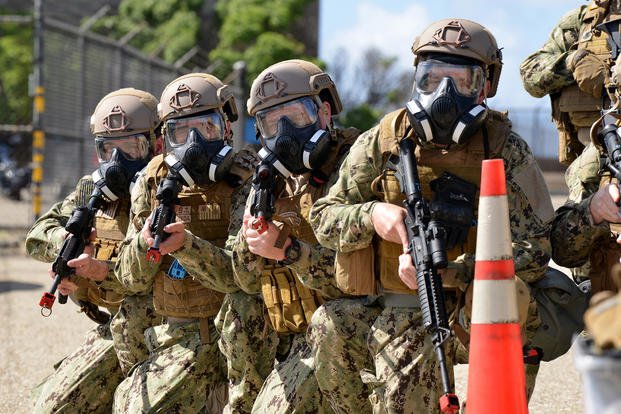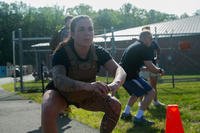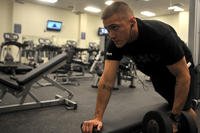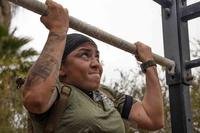I have been asked by a few future Coast Guardsmen about the new fitness test utilized by the DOG.
First of all, I had to figure out what DOG was. After some research, the good news is that the fitness test is very similar to law enforcement fitness tests used by many federal and local police agencies. Also, DOG stands for Deployable Operations Group and is considered the Coast Guard Special Ops team.
After Sept. 11, 2001, the Coast Guard became part of the Department of Homeland Security and developed the DOG in order to establish a single command authority to rapidly provide the Coast Guard, DHS, Defense Department, Justice Department and other interagency operational commanders adaptive force packages drawn from the U.S. Coast Guard's deployable specialized force units.
These six units, under a single command, create an organized quick reaction force that can be deployed to handle natural disasters, environmental catastrophes, terrorism and other threats to the United States and the world. The groups that are under DOG are the following:
MSRT -- Maritime Security Response Team
The premiere counterterrorism teams of DOG are interoperable with DOD Special Operations Forces with port security, maritime interdiction and other high-threat events.
MSST -- Maritime Safety and Security Teams
Established in 2002, these tier 1 forces are antiterrorism and port security teams who can operate domestically as well as internationally. The MSSTs execute coastal security operations (enforce security zones, port state control boardings, protection of military out loads and major marine events, augment shore-side security at waterfront facilities, detect WMD weapons/agents and participate in port level antiterrorism exercises).
NCWS -- Naval Coastal Warfare Squadrons
These Coast Guard units are part of an interoperable force and part of the DoD international and domestic security. They provide antiterrorism and force protection for forward-deployed base camps and ports around the world, as needed.
PSU -- Port Security Units
These units are integrated, interoperable and deployed nationally as well as internationally in support of DoD port security. They can deploy within 24 hours.
NSF -- National Strike Force
These Coast Guard units are immediate action teams and deploy to deal with HAZMAT, along with chemical and biological environmental disasters.
TACLET -- Tactical Law Enforcement Teams
Provide maritime drug interdiction and well as maritime interception domestically as well as where requested by the Department of Defense. They also conduct training for foreign Navy and foreign Coast Guard.
For more information on the variety of missions done by these groups, see the official Coast Guard website.
The Coast Guard Deployable Operations Group Tier 1 Fitness Test is:
|
Men/Women |
All Ages |
|
1.5-mile run |
11:38 |
|
Sit-ups 1 minute |
42 |
|
Push-ups 1 minute |
38 |
|
300-meter sprint |
48 seconds |
|
Vertical jump |
23 inches |
This test is very similar to the FBI fitness test, except for the vertical jump exercise. Training for it is not that difficult to organize into your week.
By using a standard split routine, you can organize the workout week into progressive program. For instance:
Workout 1, 3, 5: Paced cardio/upper body/abs and lower back
Workout 2, 4: Leg PT/sprinting
You can opt for a sixth workout in your seven-day week, but I recommend you give yourself 1-2 days of rest for recovery. A option for a sixth workout would be to take a day off prior and do the full test in the order that you will be taking it. This will help you alleviate any PFT anxiety, as after several times taking this test, it will become easy and feel just like another workout.
DOG Tier 2 fitness test for men and women under 30 years of age:
|
Men |
Under 30 Years Old |
|
1.5-mile run |
12:51 |
|
Sit-ups 1 minute |
38 |
|
Push-ups 1 minute |
29 |
|
12-minute swim |
500 yards |
|
Sit and reach |
16.5 inches |
|
Women |
Under 30 Years Old |
|
1.5-mile run |
15:26 |
|
Sit-ups 1 minute |
32 |
|
Push-ups 1 minute |
23 |
|
12-minute swim |
400 yards |
|
Sit and reach |
19.25 inches |
The same can be done with the Tier 2 test as far as creating a split routine to prepare for the fitness test. Here is how I would recommend training for this different test:
Workout 1, 3, 5: Run/upper body/swim/abs and lower back
Make your workouts similar for the test complete with a run, upper-body PT or weights, followed by a swim and stretch.
Workout 2, 4: Weakness day
These days can be spent working on one of the two cardio-testing events with which you are having the most trouble and resting the upper-body muscles from the day before. You also can do some leg PT to build up your leg endurance for the run.
The DOG physical fitness test exercises (tips and sample workouts):
Running
1.5-mile run:
• Pace, breathing, arm swing, stride: Learn to regulate your breathing by timing inhales for 2-3 steps and exhales for 2-3 steps in a regular breathing rhythm to keep your heart rate lower and running potential faster in the last quarter-mile.
• Arm swing and stride: Arms should be slightly bent but relaxed and swing in a straight line not crossing your body. Stride and foot strike should be efficient enough so you are not running on your toes or too wide where you land on your heels. Foot strike should be closer to the balls of the feet but not flat-footed.
• Injury prevention/stretch properly: Warm up well and stretch by jogging or doing jumping jacks and a few squats.
For more information, see these related articles.
Learn More About Special Operations Forces
Learn how to pace your 1.5-mile run by breaking the run down into quarter- and half-mile interval workouts like this:
Repeat 6-8 times.
-
Run a quarter-mile at goal pace (i.e., if your goal is to run a 10:30 1.5-mile run, then your quarter-mile should be at 1:45 each lap of the quarter-mile.
-
Rest with 100-meter walk.
-
Add in squats or lunges to build endurance in your legs as well as jumping skills.
Push-ups
The pushup is the most commonly used exercise in military, law enforcement and firefighter training programs.
Learning how to ace a fitness test is required for most groups, but being able to do multiple sets of countless push-ups usually is required in most indoctrination training programs (boot camps, basic training, military, and law enforcement and firefighting academies). Here are some tips for the exercise that has been around for thousands of years.
• Proper hand placement: Keep your hands just wider than shoulder width apart and placed lower than your shoulders as if you were doing a bench press. This will place an equal amount of force on the chest, shoulders and triceps.
• Up/down movement: This test of push-ups is a one-minute sprint. Building your endurance to do nonstop push-ups for one minute is not as difficult as it may first appear. To score your best, you should focus on doing push-ups as fast as you can. However, exert on the up motion and relax your arms when coming down. Let gravity take you down.
The workouts used to build a foundation for your push-up scores by using super set or pyramid workouts like the ones below:
Repeat 5-10 times.
Push-ups 10
Sit-ups 10-20 on pace with one-minute test goal
Push-ups pyramid: Do one push-up and build up to 25 push-ups and back down to one in as little time as possible. If you need to, "rest" by doing a timed set of 15-30 sit-ups.
Sit-ups
This exercise requires some stomach and lower-back strength as well as hip flexor/psoas strength and flexibility.
• This is a pacing exercise as with running. If your goal is 50-60 in one minute, you have to build up to withstand a pace of up to one sit-up per second for 60 seconds.
• Touch elbows to knees/shoulders to floor: This is a full repetition for the sit-up, and the best way to master this is to exert on the up movement and relax going down and let gravity take you to the floor.
• Paced sets: Focus on learning the pace to reach your goal. If your goal is 50 sit-ups in one minute, then get 25 in 30 seconds, 12-13 in 15 seconds and develop your sit-up workouts with timed sets throughout your workout.
Running speed
300-meter sprint:
• This is three-quarters of a 400-meter track and is meant to be a full sprint. Some people perform this fast run as a buildup to a full sprint and still perform well. Start off fast to build up your momentum for the first 10-20 meters, then keep that pace for the first 100 meters, pick it up a notch for the second 100, and then the last 100 is full speed.
• Build VO2 max with intervals/speed work/leg stamina through calisthenics/weights/plyometrics.
Some favorite workouts to ace this test as well as the vertical jump is to mix sprints with squat, lunges and jumps a few times a week for 4-5 sets like this:
Repeat 4-5 times.
-
300-meter fast run
-
Squats 20
-
Lunges 10/leg
-
Vertical jump 5
-
Stretch legs lightly
Vertical jump: A two-foot vertical leap is not a challenging jump. However, it is one that requires practice if you do not normally jump for sports like basketball or volleyball. Out of all athletic skills, jumping and running are the most potentially injurious, especially if you are sporting a few too many extra pounds. Being flexible, with a healthy body weight, and practicing jumping is the best way to ace this event.
Swimming tests: A 12-minute swim is a tough event if you are not an efficient swimmer. This is one of those tests that may require some special training from someone who knows how to swim well. Another way to learn is to watch a swim team practice the freestyle/crawl stroke. Otherwise, build up your swimming endurance and speed by swimming for 12-minute intervals. See my swimming articles for more information.
Get more ideas on swimming tests in the military.
Find Available Special Operations Opportunities
More USCG special training articles:
Stew Smith is a former Navy SEAL and fitness author certified as a Strength and Conditioning Specialist (CSCS) with the National Strength and Conditioning Association. Visit his Fitness eBook store if you're looking to start a workout program to create a healthy lifestyle. Send your fitness questions to stew@stewsmith.com.
Want to Learn More About Military Life?
Whether you're thinking of joining the military, looking for fitness and basic training tips, or keeping up with military life and benefits, Military.com has you covered. Subscribe to Military.com to have military news, updates and resources delivered directly to your inbox.



















